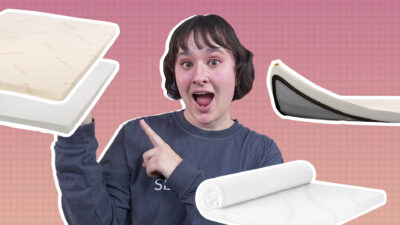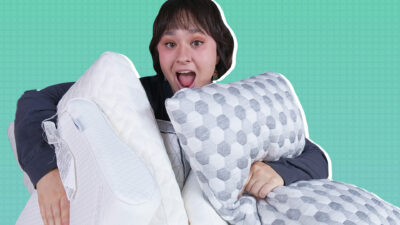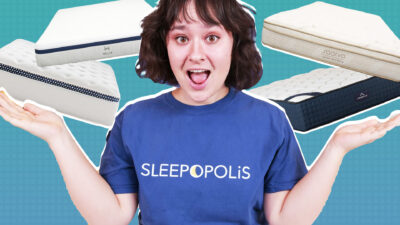Finding the most comfortable mattress for you depends on factors such as body weight, preferred sleeping position, and even body temperature. There are a lot of options out there, so we recognize that sifting through all the different mattress types on the market can get overwhelming. That’s why we put together a list of the most comfortable mattresses of the year.
And if you don’t want to take my word for it, you can skip down to my buying guide for a few tips on picking the most comfortable mattress for your needs all on your own.
Our Top Pick for Most Comfortable Mattress
Helix Midnight Luxe is our pick for the most comfortable mattress because its balanced hybrid construction should give sleepers plenty of spinal support, while the cooling pillow top and dual memory foam comfort layer provide soothing pressure relief.
Most Comfortable Mattresses of 2024
- Helix Midnight Luxe – Best Overall
- Emma Original – Most Comfortable Mattress for Lightweight Sleepers
- Nectar – Most Comfortable Mattress for Side Sleepers
- The WinkBed – Most Comfortable Mattress for Seniors
- Nolah Evolution – Most Comfortable Mattress for Hip Pain
- Saatva – Most Comfortable Mattress for Stomach Sleepers
- Bear Original – Most Comfortable Mattress for Athletes
- Brooklyn Bedding Aurora Luxe – Most Comfortable Hybrid Mattress
- Titan Plus – Most Comfortable Mattress for Back Sleepers
- Birch Luxe – Most Comfortable Organic Mattress
Read on for more in-depth information about each mattress, or skip down to the bottom to find a handy chart that compares the mattress type, price, superlative, and review of each brand.
Our Video Review of the Most Comfortable Mattress

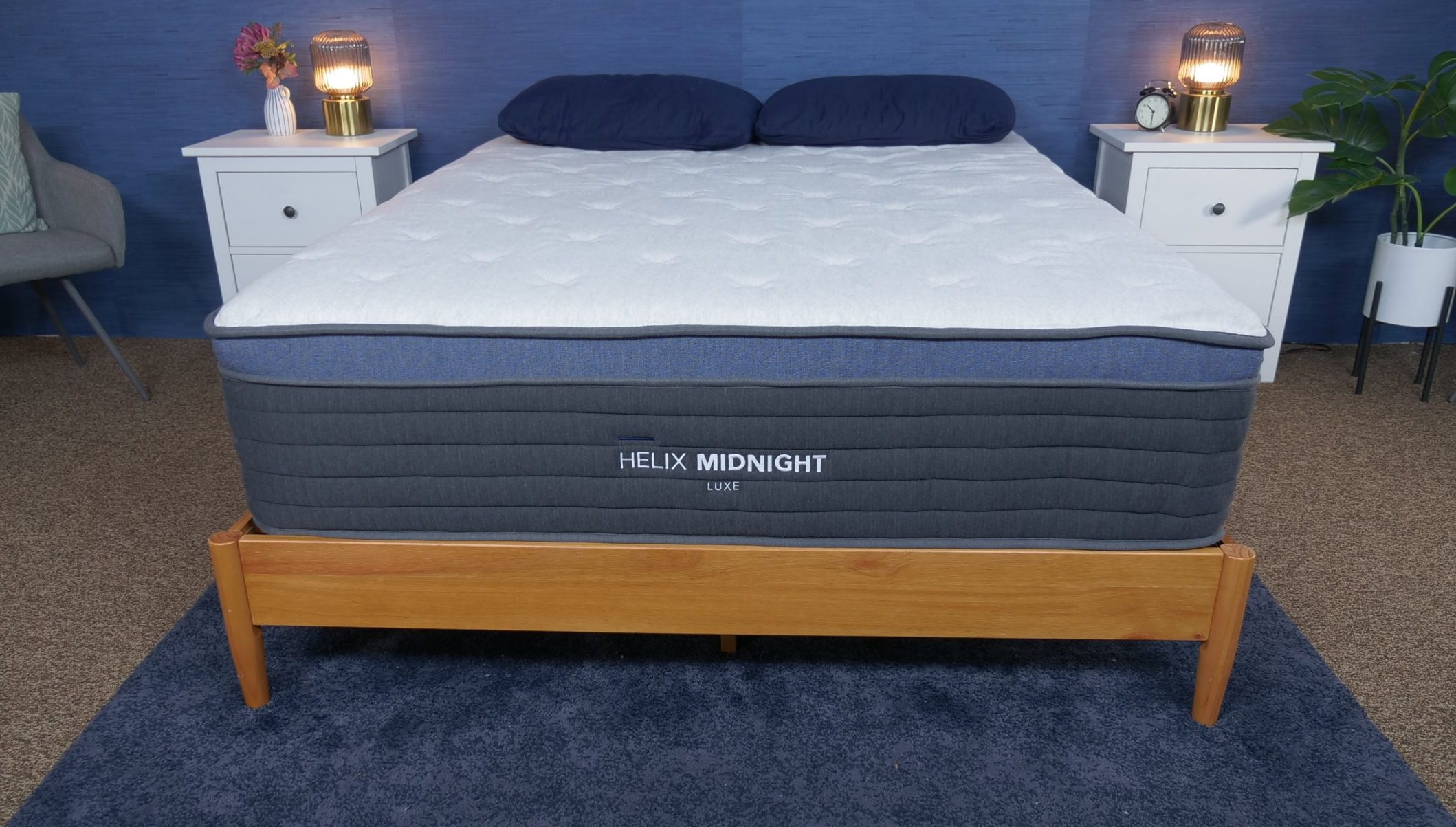
|
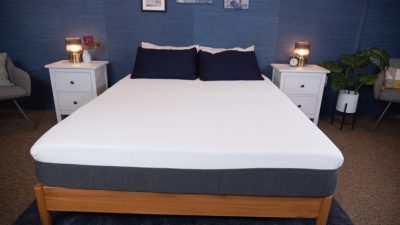
|
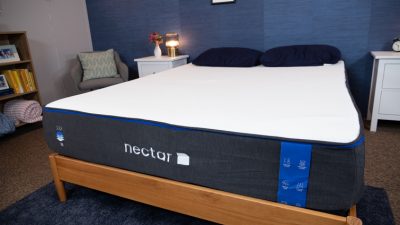
|

|
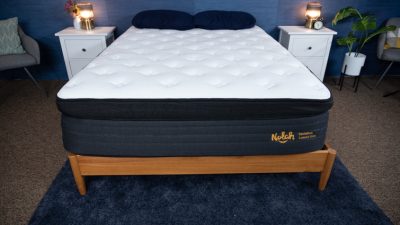
|
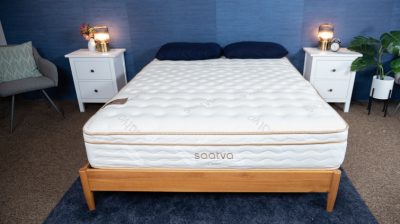
|
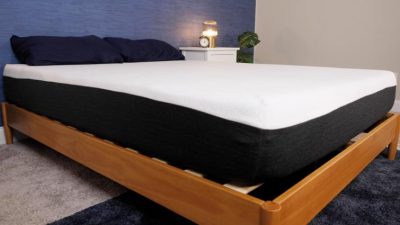
|
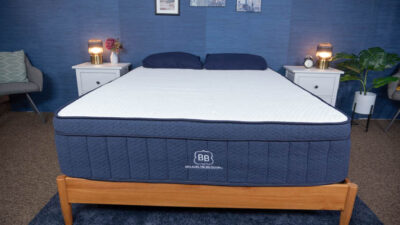
|
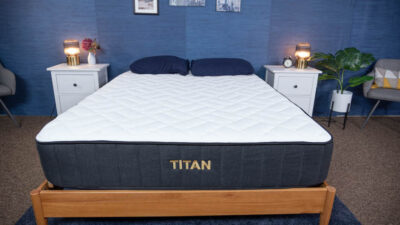
|
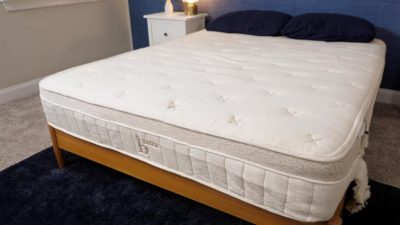
|
|
| Helix Midnight Luxe Mattress | Emma Mattress | Nectar Mattress | WinkBed Mattress | Nolah Evolution Hybrid Mattress | Saatva Mattress | Bear Original Mattress | Brooklyn Bedding Aurora Luxe Mattress | Titan Plus | Birch Luxe Natural Mattress | |
| Rating | ||||||||||
| Firmness | Medium-soft: 6/10 | Firm: 7/10 | Medium-soft: 6/10 | Multiple firmness options | Multiple firmness options | Multiple firmness options | Firm: 7.5/10 | Multiple firmness options | Firm: 7.5/10 | Firm: 7/10 |
| Material | Hybrid | Foam | Foam | Hybrid | Hybrid | Innerspring | Foam | Hybrid | Hybrid | Hybrid |
| Cooling | -- | ✓ | -- | ✓ | -- | ✓ | ✓ | ✓ | -- | -- |
| Sleep Position | Combination | Back | Back & Side | Combination | Back & Side | Back & Stomach | Back & Side | Back & Side | Back & Stomach | Back & Stomach |
Helix Midnight Luxe – Best Overall
Helix Midnight Luxe Mattress

The Helix Midnight Luxe is a supportive mattress that's great for back sleepers. The Midnight Luxe’s thick comfort layer of memory foam provides plenty of pressure relief and contouring while the zoned coils offer a great deal of support.
Material
Hybrid
Trial Period
100 nights
Shipping Method
Free shipping
Firmness
Medium-soft: 6/10
Warranty
15-year warranty
Price Range
$$$$$
We recommend this mattress for the following sleeper types:
Back Sleeping
Ideal for average weight and heavyweight back sleepers.Side Sleeping
Ideal for average weight and heavyweight side sleepers.Stomach Sleeping
Ideal for lightweight stomach sleepers.Financing Options
Financing options are available for this mattress.
Helix Midnight Luxe Mattress

The Helix Midnight Luxe is a supportive mattress that's great for back sleepers. The Midnight Luxe’s thick comfort layer of memory foam provides plenty of pressure relief and contouring while the zoned coils offer a great deal of support.
Material
Hybrid
Warranty
15-year warranty
Firmness
Medium-soft: 6/10
Shipping Method
Free shipping
Trial Period
100 nights
Price Range
$$$$$
We recommend this mattress for the following sleeper types:
Back Sleeping
Ideal for average weight and heavyweight back sleepers.Side Sleeping
Ideal for average weight and heavyweight side sleepers.Stomach Sleeping
Ideal for lightweight stomach sleepers.Financing Options
Financing options are available for this mattress.

Helix Midnight Luxe Mattress
The Helix Midnight Luxe is a supportive mattress that's great for back sleepers. The Midnight Luxe’s thick comfort layer of memory foam provides plenty of pressure relief and contouring while the zoned coils offer a great deal of support.
Material
Hybrid
Firmness
Medium-soft: 6/10
Trial Period
100 nights
Warranty
15-year warranty
Shipping Method
Free shipping
Price Range
$$$$$
We recommend this mattress for the following sleeper types:
Back Sleeping
Ideal for average weight and heavyweight back sleepers.Side Sleeping
Ideal for average weight and heavyweight side sleepers.Stomach Sleeping
Ideal for lightweight stomach sleepers.Financing Options
Financing options are available for this mattress.
Expert Opinion
The Helix Midnight Luxe, Helix’s most well-known mattress on their luxury line, is our top pick for comfort. It’s a versatile option that accommodates a number of sleeping positions, body types, and health needs. While testing in our mattress lab, we found it offers the firm coil support most back sleepers need to keep their spines straight at night. At the same time, its gentle memory foam layer contours to the lower back to offer some pressure relief in the lumbar region.
This balance of comfort and support was further confirmed by our pressure map test. The Helix Midnight Luxe showed impressive results while back sleeping, with mostly blue and just a touch of green at the hips. Folks with back pain should feel comfortable on this mattress. Side sleeping, there was a bit of green and yellow at the hip and shoulder. This is to be expected, as side sleepers put more pressure on these areas. However, those with more severe joint pain might want a softer mattress, or perhaps a soft mattress topper.
What our tester says: “I honestly understand why this is the brand’s most popular model. It’s really comfortable and supportive for back and side sleeping. I love that the Helix Midnight Luxe offers solid edge support — you can use the whole bed!” – Bridget Chapman, former senior product editor
What Customers Say
There are several customers amongst the 5,500+ Helix Midnight Luxe reviews that say they found the right mattress for them by taking Helix’s Sleep Quiz.
Pros of the the Helix Midnight Luxe
- The Helix Midnight Luxe’s hybrid construction has a breathable cover and coils that effectively promote airflow, which is why we scored it an impressive 4.5 out of 5 for cooling.
- This mattress scored a 4.5 out 5 for support and a 4 out of 5 for materials, so this quality construction should provide lots of comfort for years to come.
- We found the Midnight Luxe’s bouncy coils and proprietary foam make it easy to switch sleeping positions, so this is a nice option for combination sleepers too.
Cons of the Helix Midnight Luxe
- This mattress has a medium firmness that’s not going to be firm enough for stomach sleepers.
- It scored lower in motion isolation than other hybrids (3.5 out of 5), so it’s not the best mattress for couples who consider themselves light sleepers
Want to learn more about how the Helix Midnight Luxe can remedy your pains? Read our full review or click here for our best deal. Not sure it will be the perfect bed for you? See more options for the best mattress.
Emma Original – Most Comfortable Mattress for Lightweight Sleepers
Emma Mattress

The Emma Mattress is an all-foam bed-in-a-box mattress designed and manufactured in Germany. Its all-foam construction provides great support and comfort that back sleepers and stomach sleepers will enjoy.
Material
Foam
Trial Period
365 nights
Shipping Method
Free shipping
Firmness
Firm: 7/10
Warranty
10-year warranty
Price Range
$$$$$
We recommend this mattress for the following sleeper types:
Hot Sleepers
If you often overheat while you sleep, this mattress should help you stay cool.Kids
This bed is perfect for young sleepers.Back Sleeping
Ideal for lightweight and average weight back sleepers.Financing Options
Financing options are available for this mattress.
Emma Mattress

The Emma Mattress is an all-foam bed-in-a-box mattress designed and manufactured in Germany. Its all-foam construction provides great support and comfort that back sleepers and stomach sleepers will enjoy.
Material
Foam
Warranty
10-year warranty
Firmness
Firm: 7/10
Shipping Method
Free shipping
Trial Period
365 nights
Price Range
$$$$$
We recommend this mattress for the following sleeper types:
Hot Sleepers
If you often overheat while you sleep, this mattress should help you stay cool.Kids
This bed is perfect for young sleepers.Back Sleeping
Ideal for lightweight and average weight back sleepers.Financing Options
Financing options are available for this mattress.

Emma Mattress
The Emma Mattress is an all-foam bed-in-a-box mattress designed and manufactured in Germany. Its all-foam construction provides great support and comfort that back sleepers and stomach sleepers will enjoy.
Material
Foam
Firmness
Firm: 7/10
Trial Period
365 nights
Warranty
10-year warranty
Shipping Method
Free shipping
Price Range
$$$$$
We recommend this mattress for the following sleeper types:
Hot Sleepers
If you often overheat while you sleep, this mattress should help you stay cool.Kids
This bed is perfect for young sleepers.Back Sleeping
Ideal for lightweight and average weight back sleepers.Financing Options
Financing options are available for this mattress.
Expert Opinion
Lightweight sleepers under 150 pounds experience mattresses a little bit differently than average-weight or heavier sleepers. Because they don’t compress into the layers quite as much, beds tend to feel firmer to them. We think that lightweight sleepers could be especially comfortable on the all-foam Emma. They shouldn’t sink too far into the mattress, so they’ll feel extremely supported by the bed’s bottom layer of ergonomically designed memory foam.
Our team tested out the Emma Original using our pressure map. It showed some great results for back sleeping, and we did see a bit of orange and red (higher pressure) at the hip and shoulder. Lightweight sleepers should find back sleeping comfortable (as well as stomach sleeping, since they feel mattresses to be firmer than average). However, lightweight side sleepers should consider a softer mattress option.
What our tester says: “If you crave a supportive foam mattress that still gives you some contouring, the Emma won’t steer you wrong. It features a moderate level of body-contouring and sinkage, but its Airgocell layer balances things out on top.” – Bridget Chapman, former senior product editor
What Customers Say
65,000+ verified customers left reviews on the Emma website, and many of them note that this mattress has an overall seamless delivery and a lengthy sleep trial.
Pros of the Emma Original
- Although foam mattresses usually sleep hotter than innerspring or hybrid beds, we found that the Emma easily kept a low temperature due to its cooling cover and open-celled foam.
- Even lightweight and average-weight stomach sleepers should have no problem keeping elevated, with their hips propped up and staying in line with their shoulders.
- The dense poly foam and cushioning comfort layer result in a balance that’s ideal for back sleeping.
Cons of the Emma Original
- The only sleeping position we wouldn’t recommend the Emma for is lightweight side sleepers, who will likely need a softer mattress with more pressure relief.
Read our full Emma mattress review or click here for our best deal. Still shopping? See our other best mattresses for lightweight sleepers.
Nectar – Most Comfortable Mattress for Side Sleepers
Nectar Mattress

The original Nectar mattress is a pressure-relieving, yet supportive, bed. It’s made with a thick layer of gel memory foam, which allows the sleeper to really sink into its surface.
Material
Foam
Trial Period
365 nights
Shipping Method
Free shipping
Firmness
Medium-soft: 6/10
Warranty
Lifetime warranty
Price Range
$$$$$
We recommend this mattress for the following sleeper types:
Joint Pain
This bed is perfect for anyone suffering from joint pain.Hip Pain
This bed is perfect for anyone suffering from hip pain.Back Sleeping
Ideal for lightweight and average weight back sleepers.Side Sleeping
Ideal for lightweight and average weight side sleepers.Financing Options
Financing options are available for this mattress.
I dreaded paying for a new mattress but my old one was 15 years old…buying a Nectar was the best choice I could have made! It is so comfortable and didn’t cost an arm and a leg. I would absolutely recommend this mattress to anyone!
Kaitlynne S., Nectar customerNectar Mattress

The original Nectar mattress is a pressure-relieving, yet supportive, bed. It’s made with a thick layer of gel memory foam, which allows the sleeper to really sink into its surface.
Material
Foam
Warranty
Lifetime warranty
Firmness
Medium-soft: 6/10
Shipping Method
Free shipping
Trial Period
365 nights
Price Range
$$$$$
We recommend this mattress for the following sleeper types:
Joint Pain
This bed is perfect for anyone suffering from joint pain.Hip Pain
This bed is perfect for anyone suffering from hip pain.Back Sleeping
Ideal for lightweight and average weight back sleepers.Side Sleeping
Ideal for lightweight and average weight side sleepers.Financing Options
Financing options are available for this mattress.
I dreaded paying for a new mattress but my old one was 15 years old…buying a Nectar was the best choice I could have made! It is so comfortable and didn’t cost an arm and a leg. I would absolutely recommend this mattress to anyone!
Kaitlynne S., Nectar customer
Nectar Mattress
The original Nectar mattress is a pressure-relieving, yet supportive, bed. It’s made with a thick layer of gel memory foam, which allows the sleeper to really sink into its surface.
Material
Foam
Firmness
Medium-soft: 6/10
Trial Period
365 nights
Warranty
Lifetime warranty
Shipping Method
Free shipping
Price Range
$$$$$
We recommend this mattress for the following sleeper types:
Joint Pain
This bed is perfect for anyone suffering from joint pain.Hip Pain
This bed is perfect for anyone suffering from hip pain.Back Sleeping
Ideal for lightweight and average weight back sleepers.Side Sleeping
Ideal for lightweight and average weight side sleepers.Financing Options
Financing options are available for this mattress.
I dreaded paying for a new mattress but my old one was 15 years old…buying a Nectar was the best choice I could have made! It is so comfortable and didn’t cost an arm and a leg. I would absolutely recommend this mattress to anyone!
Kaitlynne S., Nectar customerExpert Opinion
The Nectar is a memory foam mattress that tested incredibly well in our mattress lab for side sleepers, as its thick foam layers offer plenty of pressure relief at the shoulders and hips. This bed is built for average-weight side sleepers and should provide maximum contouring and cushioning.
Our pressure map revealed very little pressure buildup while side sleeping, even at the hip and shoulder. So, whether you’re a perfectly healthy side sleeper or if you have issues with joint pain, you should feel contoured and comfortable.
What our tester says: “I think the Nectar has a great classic memory foam feel. If you love deep sinkage and contouring, this is the mattress for you. I especially like this feel for back and side sleepers, who should find their pressure points cushioned, and spines supported.” – Bridget Chapman, former senior product editor
What Customers Say
With a whopping 57,000+ customer reviews on the company website, the Nectar has many positive comments on waking up pain-free and well-rested.
Pros of the Nectar
- Lightweight and average-weight back sleepers who enjoy soft support and a plush feel could also like this mattress.
- The Nectar has a traditional sinking memory foam feel. Although memory foam tends to sleep hot, the Nectar regulates temperature with a cooling cover and cooling foams, allowing it to sleep cooler than most memory foam beds.
- The Nectar offers a queen size bed for well under $1,000 after considering sales and discounts.
Cons of the Nectar
- This mattress wasn’t built with the materials of a high enough density or support level to accommodate heavy sleepers.
- The Nectar isn’t nearly firm enough for stomach sleepers. They’ll likely sink into the mattress too far.
You can find out more in our full review of the Nectar or click here for our best deal. Not sure if it’s the right mattress for you? Check out the other best mattresses for side sleepers.
The WinkBed – Most Comfortable Mattress for Seniors
WinkBed Mattress

The WinkBed is a hybrid mattress that comes in three firmness levels, so most sleepers should find a model that suits their needs. It could also be a good fit for couples, thanks to reinforced edge support.
Material
Hybrid
Trial Period
120 nights
Shipping Method
Free shipping
Firmness
Multiple firmness options
Warranty
Lifetime warranty
Price Range
$$$$$
We recommend this mattress for the following sleeper types:
Hot Sleepers
If you often overheat while you sleep, this mattress should help you stay cool.Back Pain
This bed is perfect for anyone suffering from back pain.Back Sleeping
Ideal for lightweight and average weight back sleepers.Side Sleeping
Ideal for lightweight and average weight side sleepers.Stomach Sleeping
Ideal for average weight stomach sleepers.Financing Options
Financing options are available for this mattress.
Absolutely the greatest mattress I've ever slept on. It is soft yet firm in the right spots. Quality is on another level. You get what you pay for.
Sobhana P., WinkBeds customerWinkBed Mattress

The WinkBed is a hybrid mattress that comes in three firmness levels, so most sleepers should find a model that suits their needs. It could also be a good fit for couples, thanks to reinforced edge support.
Material
Hybrid
Warranty
Lifetime warranty
Firmness
Multiple firmness options
Shipping Method
Free shipping
Trial Period
120 nights
Price Range
$$$$$
We recommend this mattress for the following sleeper types:
Hot Sleepers
If you often overheat while you sleep, this mattress should help you stay cool.Back Pain
This bed is perfect for anyone suffering from back pain.Back Sleeping
Ideal for lightweight and average weight back sleepers.Side Sleeping
Ideal for lightweight and average weight side sleepers.Stomach Sleeping
Ideal for average weight stomach sleepers.Financing Options
Financing options are available for this mattress.
Absolutely the greatest mattress I've ever slept on. It is soft yet firm in the right spots. Quality is on another level. You get what you pay for.
Sobhana P., WinkBeds customer
WinkBed Mattress
The WinkBed is a hybrid mattress that comes in three firmness levels, so most sleepers should find a model that suits their needs. It could also be a good fit for couples, thanks to reinforced edge support.
Material
Hybrid
Firmness
Multiple firmness options
Trial Period
120 nights
Warranty
Lifetime warranty
Shipping Method
Free shipping
Price Range
$$$$$
We recommend this mattress for the following sleeper types:
Hot Sleepers
If you often overheat while you sleep, this mattress should help you stay cool.Back Pain
This bed is perfect for anyone suffering from back pain.Back Sleeping
Ideal for lightweight and average weight back sleepers.Side Sleeping
Ideal for lightweight and average weight side sleepers.Stomach Sleeping
Ideal for average weight stomach sleepers.Financing Options
Financing options are available for this mattress.
Absolutely the greatest mattress I've ever slept on. It is soft yet firm in the right spots. Quality is on another level. You get what you pay for.
Sobhana P., WinkBeds customerExpert Opinion
Seniors tend to prefer more traditional innerspring mattresses, so the WinkBed should be right up their alley. It’s a Euro pillow top hybrid mattress with a traditional innerspring feel. This bed is delivered in a box, which is a nice feature for seniors who don’t want to deal with a mattress store. We do recommend checking the weight of the box before trying to lift it.
During testing, we found it to be excellent for back pain (especially on the Luxury Firm version) and joint pain (we recommend the Softer version). We discovered this by putting the WinkBed mattress through our pressure map test. We set the mat on the mattress surface. The map then uses our body temperature to identify areas of high pressure buildup (indicated by the colors red and orange), moderate buildup (yellow), and low pressure buildup (green and blue).
What our tester says: “One of my favorite things about the WinkBed is its durability. This is a high-quality mattress that should really stand the test of time. This is great news for any sleeper, but especially nice for heavy people and couples.” – Bridget Chapman, former senior product editor
What Customers Say
There are almost 3,200 reviews on the company site. Many of these WinkBed customers have great things to say about the customer service throughout the ordering process.
Pros of the WinkBed
- The WinkBed’s classic, bouncy feel will help seniors and combination sleepers feel more “on top of” this bed than “in it,” which means it should be easy for them to move around and change positions at night.
- The WinkBed also sleeps really cool thanks to its pocketed coil layer, adding some nice airflow through the mattress.
- This mattress is offered in a variety of firmness options, so most people should be able to find a model that feels comfortable to them.
Cons of the WinkBed
- While it’s not the most expensive mattress we’ve seen, its quality construction and materials don’t make it the cheapest. However, WinkBed frequently offers sales and discounts that could bring this bed down to a better price range.
To learn more, check out our full review or click here for our best deal. Still not sure if the WinkBed is right for you? Browse our other top picks for best mattress for seniors.
Nolah Evolution – Most Comfortable Mattress for Hip Pain
Nolah Evolution Hybrid Mattress

The Nolah Evolution provides good pressure relief and body contouring. It’s a great choice for side sleepers, and back sleepers who like a softer mattress will enjoy it too. The soft pillow top is a great touch for shoulder or hip pain as well.
Material
Hybrid
Trial Period
120 nights
Shipping Method
Free shipping
Firmness
Multiple firmness options
Warranty
Lifetime warranty
Price Range
$$$$$
We recommend this mattress for the following sleeper types:
Back Sleeping
Ideal for lightweight and average weight back sleepers.Side Sleeping
Ideal for lightweight and average weight side sleepers.Financing Options
Financing options are available for this mattress.
An amazing mattress! Constructed with luxuriously well made materials that are breathable and incredibly comfortable. After almost one year of sleeping on this mattress, my husband and I are still talking about how much we love it. We both are combo sleepers and feel it's the perfect balance between soft and firm. Plus, no more waking up with a sore back or tight neck. Would highly recommend!!
Hannah Merrifield, Nolah customerNolah Evolution Hybrid Mattress

The Nolah Evolution provides good pressure relief and body contouring. It’s a great choice for side sleepers, and back sleepers who like a softer mattress will enjoy it too. The soft pillow top is a great touch for shoulder or hip pain as well.
Material
Hybrid
Warranty
Lifetime warranty
Firmness
Multiple firmness options
Shipping Method
Free shipping
Trial Period
120 nights
Price Range
$$$$$
We recommend this mattress for the following sleeper types:
Back Sleeping
Ideal for lightweight and average weight back sleepers.Side Sleeping
Ideal for lightweight and average weight side sleepers.Financing Options
Financing options are available for this mattress.
An amazing mattress! Constructed with luxuriously well made materials that are breathable and incredibly comfortable. After almost one year of sleeping on this mattress, my husband and I are still talking about how much we love it. We both are combo sleepers and feel it's the perfect balance between soft and firm. Plus, no more waking up with a sore back or tight neck. Would highly recommend!!
Hannah Merrifield, Nolah customer
Nolah Evolution Hybrid Mattress
The Nolah Evolution provides good pressure relief and body contouring. It’s a great choice for side sleepers, and back sleepers who like a softer mattress will enjoy it too. The soft pillow top is a great touch for shoulder or hip pain as well.
Material
Hybrid
Firmness
Multiple firmness options
Trial Period
120 nights
Warranty
Lifetime warranty
Shipping Method
Free shipping
Price Range
$$$$$
We recommend this mattress for the following sleeper types:
Back Sleeping
Ideal for lightweight and average weight back sleepers.Side Sleeping
Ideal for lightweight and average weight side sleepers.Financing Options
Financing options are available for this mattress.
An amazing mattress! Constructed with luxuriously well made materials that are breathable and incredibly comfortable. After almost one year of sleeping on this mattress, my husband and I are still talking about how much we love it. We both are combo sleepers and feel it's the perfect balance between soft and firm. Plus, no more waking up with a sore back or tight neck. Would highly recommend!!
Hannah Merrifield, Nolah customerExpert Opinion
The right mattress for relieving hip pain will have a cushioning top layer that allows you to sink in a little. This sinkage will cushion the pressure points at your hips and shoulders, which will help relieve pain in those areas. During our pressure map test, we found the Nolah Evolution showed low pressure at the hip and shoulder, meaning this is a comfortable option for those who battle joint pain at night.
What our tester says: “I love how the Nolah Evolution comes in three different firmness models, so you can choose the best fit for you. For the Luxury Firm model, I really appreciate its medium-firm feel. This mattress provides good pressure relief and body contouring.” – Bridget Chapman, former senior product editor
What Customers Say
The reviews are full of side sleepers who enjoy the Nolah Evolution’s pressure relief and cushioning around sensitive areas like the shoulder and hip.
Pros of the Nolah Evolution
- For back sleepers, this medium-firm mattress (a 6.5/10 on our firmness scale) should provide proper cushioning at the hips but also the support to lift them into alignment.
- This luxury mattress is not only cushioning enough for hip pain, but also for side sleeping.
- The Nolah Evolution isolates motion well, so couples shouldn’t feel each other tossing and turning.
Cons of the Nolah Evolution
- For the most part, this bed isn’t going to keep stomach sleepers’ hips lifted and in proper alignment during the night. Lightweight stomach sleepers are the only exception here, and should actually feel very supported on the Nolah Evolution.
- With luxurious features and impressive technology, the Nolah Evolution is priced at around $2,500 for a queen. It’s not the best pick for budget shoppers.
Want to see if the Nolah Evolution is the perfect mattress for your hips pain? Read our full review or get our best deal here. Not sold yet? You might find what you’re looking for in our best mattress for hip pain round up.
Saatva – Most Comfortable Mattress for Stomach Sleepers
Saatva Mattress

The Saatva’s coil-on-coil construction provides a classic innerspring feel. It's a good option for combo sleepers, who will want to feel free to switch positions and avoid feeling “stuck” in the mattress. It comes in three firmness levels, so you should be able to find one that suits your needs.
Material
Innerspring
Trial Period
365 nights
Shipping Method
Free white glove delivery
Firmness
Multiple firmness options
Warranty
Lifetime warranty
Price Range
$$$$$
We recommend this mattress for the following sleeper types:
Hot Sleepers
If you often overheat while you sleep, this mattress should help you stay cool.Back Pain
This bed is perfect for anyone suffering from back pain.Back Sleeping
Ideal for lightweight, average weight, and heavyweight back sleepers.Stomach Sleeping
Ideal for lightweight and average weight stomach sleepers.Financing Options
Financing options are available for this mattress.
We were skeptical of buying a mattress on line but it could not have gone any smoother. Anthony answered all of our questions during our many phone conversations. Delivery was prompt and went without a hitch. Best of all the mattress is so comfortable! I haven't had such a good night sleep in years. Highly recommend this.
Patty, Saatva customerSaatva Mattress

The Saatva’s coil-on-coil construction provides a classic innerspring feel. It's a good option for combo sleepers, who will want to feel free to switch positions and avoid feeling “stuck” in the mattress. It comes in three firmness levels, so you should be able to find one that suits your needs.
Material
Innerspring
Warranty
Lifetime warranty
Firmness
Multiple firmness options
Shipping Method
Free white glove delivery
Trial Period
365 nights
Price Range
$$$$$
We recommend this mattress for the following sleeper types:
Hot Sleepers
If you often overheat while you sleep, this mattress should help you stay cool.Back Pain
This bed is perfect for anyone suffering from back pain.Back Sleeping
Ideal for lightweight, average weight, and heavyweight back sleepers.Stomach Sleeping
Ideal for lightweight and average weight stomach sleepers.Financing Options
Financing options are available for this mattress.
We were skeptical of buying a mattress on line but it could not have gone any smoother. Anthony answered all of our questions during our many phone conversations. Delivery was prompt and went without a hitch. Best of all the mattress is so comfortable! I haven't had such a good night sleep in years. Highly recommend this.
Patty, Saatva customer
Saatva Mattress
The Saatva’s coil-on-coil construction provides a classic innerspring feel. It's a good option for combo sleepers, who will want to feel free to switch positions and avoid feeling “stuck” in the mattress. It comes in three firmness levels, so you should be able to find one that suits your needs.
Material
Innerspring
Firmness
Multiple firmness options
Trial Period
365 nights
Warranty
Lifetime warranty
Shipping Method
Free white glove delivery
Price Range
$$$$$
We recommend this mattress for the following sleeper types:
Hot Sleepers
If you often overheat while you sleep, this mattress should help you stay cool.Back Pain
This bed is perfect for anyone suffering from back pain.Back Sleeping
Ideal for lightweight, average weight, and heavyweight back sleepers.Stomach Sleeping
Ideal for lightweight and average weight stomach sleepers.Financing Options
Financing options are available for this mattress.
We were skeptical of buying a mattress on line but it could not have gone any smoother. Anthony answered all of our questions during our many phone conversations. Delivery was prompt and went without a hitch. Best of all the mattress is so comfortable! I haven't had such a good night sleep in years. Highly recommend this.
Patty, Saatva customerExpert Opinion
Stomach sleepers need a firm mattress to keep their hips lifted up in line with their shoulders. This will keep their spines neutrally aligned and help prevent back pain. Thanks to our mattress testing methods, we found the Saatva is a firm innerspring mattress that does just this and should work well for stomach sleepers of any weight. The Saatva has three different firmnesses, but we definitely recommend the Firm version for maximum support.
What our tester says: “The Saatva Classic is a bouncy, high-quality mattress with durability and great edge support. I think it’s a nice option for back sleepers and combination sleepers.” – Bridget Chapman, former senior product editor
What Customers Say
Shoppers are extremely happy with Saatva’s free white glove delivery, as it’s not the most common perk in the mattress world. The company will actually put together your brand-new mattress and help dispose of your old mattress, saving time and energy.
Pros of the Saatva
- In addition to offering the right amount of support for stomach sleepers, the Saatva’s firm innerspring support layer provides some nice bounce for combination sleepers. You’ll feel more “on top of” than “in” this bed, which means you’ll be able to change positions easily at night.
- The Saatva also features great edge support, which means you can really spread out over its entire surface. This is a great perk for heavier people who want to avoid premature mattress sagging.
- This is a durable, cooling, supportive mattress that’s made with incredibly high-quality materials. It’s a great option for luxury shoppers.
Cons of the Saatva
- If you like the slow-moving feel of memory foam, then you likely won’t like the Saatva. It’s an innerspring-style mattress, so it doesn’t offer the kind of contouring and sinkage that a memory foam mattress would.
Get the full scoop in our comprehensive Saatva mattress review or click here for our best deal. Not sure if the Saatva will provide you with the support you need? Take a look at our other top picks for best mattress for stomach sleepers.
Bear Original – Most Comfortable Mattress for Athletes
Bear Original Mattress

We appreciate the firm and responsive feel of the Bear mattress. Its combination of support and pressure relief makes it an awesome option for anyone struggling with back pain. The Celliant cover also does a great job of keeping the mattress cool.
Material
Foam
Trial Period
120 nights
Shipping Method
Free shipping
Firmness
Firm: 7.5/10
Warranty
Lifetime warranty
Price Range
$$$$$
We recommend this mattress for the following sleeper types:
Hot Sleepers
If you often overheat while you sleep, this mattress should help you stay cool.Back Sleeping
Ideal for lightweight and average weight back sleepers.Side Sleeping
Ideal for lightweight and average weight side sleepers.Financing Options
Financing options are available for this mattress.
Bear Original Mattress

We appreciate the firm and responsive feel of the Bear mattress. Its combination of support and pressure relief makes it an awesome option for anyone struggling with back pain. The Celliant cover also does a great job of keeping the mattress cool.
Material
Foam
Warranty
Lifetime warranty
Firmness
Firm: 7.5/10
Shipping Method
Free shipping
Trial Period
120 nights
Price Range
$$$$$
We recommend this mattress for the following sleeper types:
Hot Sleepers
If you often overheat while you sleep, this mattress should help you stay cool.Back Sleeping
Ideal for lightweight and average weight back sleepers.Side Sleeping
Ideal for lightweight and average weight side sleepers.Financing Options
Financing options are available for this mattress.

Bear Original Mattress
We appreciate the firm and responsive feel of the Bear mattress. Its combination of support and pressure relief makes it an awesome option for anyone struggling with back pain. The Celliant cover also does a great job of keeping the mattress cool.
Material
Foam
Firmness
Firm: 7.5/10
Trial Period
120 nights
Warranty
Lifetime warranty
Shipping Method
Free shipping
Price Range
$$$$$
We recommend this mattress for the following sleeper types:
Hot Sleepers
If you often overheat while you sleep, this mattress should help you stay cool.Back Sleeping
Ideal for lightweight and average weight back sleepers.Side Sleeping
Ideal for lightweight and average weight side sleepers.Financing Options
Financing options are available for this mattress.
Expert Opinion
The Bear Original was designed for athletes. The company offers an additional mattress cover on the Bear Original that is made of a material called Celliant. Many studies suggest that this material could help with athletic recovery by promoting blood flow while you sleep. During testing, we found that Celliant is extremely breathable, which helps the mattress sleep cool — an essential trait if your body temperature is up after a rigorous workout. This cover does cost an additional $130, however, so make sure to keep that in mind before clicking “check out” on the Bear Original.
What our tester says: “I really appreciate the firm and responsive feel of the Bear mattress. Its combination of support and pressure relief makes it an great option for back sleepers struggling with back pain.” – Bridget Chapman, former senior product editor
What Customers Say
The Bear mattress has over 10,000 reviews on the company website. Many back to side combination sleepers find it to be a comfortable yet supportive bed.
Pros of the Bear Original
- The Bear’s medium-firm feel and balance of comfort and support makes it a great mattress for back sleepers.
- It’s an excellent budget option. Queen size Bear mattresses cost less than $1,000, and that’s before discounts.
- The Bear is one of the best memory foam mattresses on the market.
Cons of the Bear Original
- The Bear tested a bit too firm for side sleepers, who might find that the firmness of the Bear doesn’t provide adequate pressure relief.
Still deciding whether or not you want to hibernate on the Bear? Dash over to our full review, check out our roundup of the best mattresses for athletes, click here for our best deal on the Bear.
Brooklyn Bedding Aurora Luxe – Most Comfortable Hybrid Mattress
Brooklyn Bedding Aurora Luxe Mattress

The Brooklyn Bedding Aurora Luxe is a hybrid bed-in-a-box mattress. It comes in three firmness levels and with an optional Cloud Pillow Top, so sleepers can pick the best model for their needs. It also has cooling tech in nearly every layer, which means it sleeps super cool!
Material
Hybrid
Trial Period
120 nights
Shipping Method
Free shipping
Firmness
Multiple firmness options
Warranty
10-year warranty
Price Range
$$$$$
We recommend this mattress for the following sleeper types:
Hot Sleepers
If you often overheat while you sleep, this mattress should help you stay cool.Back Pain
This bed is perfect for anyone suffering from back pain.Side Sleeping
Ideal for average weight side sleepers.Financing Options
Financing options are available for this mattress.
Brooklyn Bedding Aurora Luxe Mattress

The Brooklyn Bedding Aurora Luxe is a hybrid bed-in-a-box mattress. It comes in three firmness levels and with an optional Cloud Pillow Top, so sleepers can pick the best model for their needs. It also has cooling tech in nearly every layer, which means it sleeps super cool!
Material
Hybrid
Warranty
10-year warranty
Firmness
Multiple firmness options
Shipping Method
Free shipping
Trial Period
120 nights
Price Range
$$$$$
We recommend this mattress for the following sleeper types:
Hot Sleepers
If you often overheat while you sleep, this mattress should help you stay cool.Back Pain
This bed is perfect for anyone suffering from back pain.Side Sleeping
Ideal for average weight side sleepers.Financing Options
Financing options are available for this mattress.

Brooklyn Bedding Aurora Luxe Mattress
The Brooklyn Bedding Aurora Luxe is a hybrid bed-in-a-box mattress. It comes in three firmness levels and with an optional Cloud Pillow Top, so sleepers can pick the best model for their needs. It also has cooling tech in nearly every layer, which means it sleeps super cool!
Material
Hybrid
Firmness
Multiple firmness options
Trial Period
120 nights
Warranty
10-year warranty
Shipping Method
Free shipping
Price Range
$$$$$
We recommend this mattress for the following sleeper types:
Hot Sleepers
If you often overheat while you sleep, this mattress should help you stay cool.Back Pain
This bed is perfect for anyone suffering from back pain.Side Sleeping
Ideal for average weight side sleepers.Financing Options
Financing options are available for this mattress.
Expert Opinion
Hybrid mattresses combine the comfort of foam and the support of coils, making them a good match for just about anyone. And when it comes to these types of beds, the Brooklyn Aurora Luxe is one of the best hybrids we’ve tested. While it has zoned coils in its support layer, its foams treat sleepers to an exceptional amount of softness and pressure relief (it scored a 5.5/10 on our mattress firmness scale). This was further exemplified on our pressure map test, where we saw effective cushioning while back sleeping in particular.
What our tester says: “My favorite thing about this bed is how cooling it is. Even some of the best soft mattresses tend to sleep a little hot because of the snuggly foams they use. The Aurora Luxe really solves this problem with Phase Change Material and breathable pocketed coils.” – Bridget Chapman, former senior product editor
What Customers Say
Many couples report positive experiences on the Brooklyn Bedding Aurora Luxe. We can attest to this, as this mattress tested well in cooling, motion isolation, responsiveness, and edge support.
Pros of the Brooklyn Bedding Aurora Luxe
- The Brooklyn Bedding Aurora Luxe sleeps very cool. The coils promote airflow, and both the cover and comfort layer contain Phase Change Material, a fabric that’s cool to the touch and adjusts its temperature with your body heat.
- Side sleepers should feel the softness in a contouring layer of proprietary TitanFlex foam, a responsive material that also gives some extra cushioning around the body’s pressure points.
- The same pressure-relieving qualities that make this a good mattress for side sleepers also make this a solid option for joint pain.
Cons of the Brooklyn Bedding Aurora Luxe
- This bed is offered in three different firmnesses (Soft, Medium, and Firm), but we still think stomach sleepers would be better off with a firmer mattress.
Click here for our best deal or read our full review to see if the Brooklyn Bedding Aurora Luxe is the hybrid mattress you’ve been looking for. Still looking for your perfect hybrid? Check out our other hybrid mattress picks.
Titan Plus – Most Comfortable Mattress for Back Sleepers
Titan Plus

The Titan Firm Hybrid from Brooklyn Bedding is a durable mattress featuring 6-inch heavy-duty support coils, making it a great option for heavier sleepers. This mattress also has a Titanflex foam comfort layer, which provides nice lift and bounce for heavier weights.
Material
Hybrid
Trial Period
120 nights
Shipping Method
Free shipping
Firmness
Firm: 7.5/10
Warranty
10-year warranty
Price Range
$$$$$
We recommend this mattress for the following sleeper types:
Back Pain
This bed is perfect for anyone suffering from back pain.Back Sleeping
Ideal for heavyweight back sleepers.Stomach Sleeping
Ideal for heavyweight stomach sleepers.Financing Options
Financing options are available for this mattress.
Get this bed right now! Simply amazing. Does not sag in the middle at all. Best sleep I've had in a very long time.
Shante, Brooklyn Bedding customerTitan Plus

The Titan Firm Hybrid from Brooklyn Bedding is a durable mattress featuring 6-inch heavy-duty support coils, making it a great option for heavier sleepers. This mattress also has a Titanflex foam comfort layer, which provides nice lift and bounce for heavier weights.
Material
Hybrid
Warranty
10-year warranty
Firmness
Firm: 7.5/10
Shipping Method
Free shipping
Trial Period
120 nights
Price Range
$$$$$
We recommend this mattress for the following sleeper types:
Back Pain
This bed is perfect for anyone suffering from back pain.Back Sleeping
Ideal for heavyweight back sleepers.Stomach Sleeping
Ideal for heavyweight stomach sleepers.Financing Options
Financing options are available for this mattress.
Get this bed right now! Simply amazing. Does not sag in the middle at all. Best sleep I've had in a very long time.
Shante, Brooklyn Bedding customer
Titan Plus
The Titan Firm Hybrid from Brooklyn Bedding is a durable mattress featuring 6-inch heavy-duty support coils, making it a great option for heavier sleepers. This mattress also has a Titanflex foam comfort layer, which provides nice lift and bounce for heavier weights.
Material
Hybrid
Firmness
Firm: 7.5/10
Trial Period
120 nights
Warranty
10-year warranty
Shipping Method
Free shipping
Price Range
$$$$$
We recommend this mattress for the following sleeper types:
Back Pain
This bed is perfect for anyone suffering from back pain.Back Sleeping
Ideal for heavyweight back sleepers.Stomach Sleeping
Ideal for heavyweight stomach sleepers.Financing Options
Financing options are available for this mattress.
Get this bed right now! Simply amazing. Does not sag in the middle at all. Best sleep I've had in a very long time.
Shante, Brooklyn Bedding customerExpert Opinion
As a general rule, back sleepers thrive when sleeping on a medium-firm to firm mattress, which means they should seek out a bed that’s around a 6.5–7.5 out of 10 on the firmness scale. That’s roughly what most sleepers around 200 pounds should feel on the Titan Plus, a bed made with ultimate support and durability in mind. Back sleepers also need a mattress that fills in the lumbar region while lifting the body into alignment, and with its hybrid construction, the Titan Plus achieves both.
Our pressure map test further confirmed that the Titan Plus works especially well in the back-sleeping position, whether you’re a average weight sleeper or heavyweight sleeper. The pressure map showed entirely blue, and this kind of pressure relief doesn’t come around every day. We received some good results for side sleeping as well, and though there was a bit of pressure buildup at the shoulder and hip, this is normal.
What our tester says: “Based on our testing observations as well as the pressure map results, we think back sleepers with back pain and joint pain should fare well on this mattress.” – Bridget Chapman, former senior product editor
What Customers Say
For the most part, shoppers were pleased with the level of quality they get from the Titan Plus, especially considering its value cost.
Pros of the Titan Plus
- The edge support on the Titan Plus is reinforced. This makes the bed a good option for couples. They should be able to spread out on the entire surface of the mattress without feeling like they’re going to fall off.
- This mattress has a coil system that makes it responsive — or bouncy — in nature. This quality is valued amongst combination sleepers, who seek an “on top of” feel that makes it easy to move around.
- The Titan Plus, given its firmer nature, should accommodate stomach sleepers with back pain and joint pain as well.
Cons of the Titan Plus
- There just isn’t an adequate enough pressure relief for strict lightweight side sleepers, so they might feel buildup at the hip and shoulder.
Ready to check out this mattress? Click here for our best deal or see our full Titan Plus mattress review. Still shopping? Take a gander at our other best mattresses for back sleepers.
Birch Luxe – Most Comfortable Organic Mattress
Birch Luxe Natural Mattress

The Birch Luxe mattress is an eco-friendly and plush hybrid mattress by Helix Sleep. It's designed to sleep cool and assist with muscle recovery.
Material
Hybrid
Trial Period
100 Nights
Shipping Method
Free shipping
Firmness
Firm: 7/10
Warranty
25-year warranty
Price Range
$$$$$
Birch Luxe Natural Mattress

The Birch Luxe mattress is an eco-friendly and plush hybrid mattress by Helix Sleep. It's designed to sleep cool and assist with muscle recovery.
Material
Hybrid
Warranty
25-year warranty
Firmness
Firm: 7/10
Shipping Method
Free shipping
Trial Period
100 Nights
Price Range
$$$$$

Birch Luxe Natural Mattress
The Birch Luxe mattress is an eco-friendly and plush hybrid mattress by Helix Sleep. It's designed to sleep cool and assist with muscle recovery.
Material
Hybrid
Firmness
Firm: 7/10
Trial Period
100 Nights
Warranty
25-year warranty
Shipping Method
Free shipping
Price Range
$$$$$
Expert Opinion
A crucial consideration for many is the materials that go into a mattress’s construction. With the organic Birch Luxe, you don’t have to worry. Organic cotton, organic wool, natural Talalay latex, and pocketed coils create this high-quality hybrid mattress. We like this bed for back sleepers and stomach sleepers of most body types, as it has a firmer feel.
What our tester says: “I love that the Birch Luxe is an eco-friendly model. I think a lot of people would find comfort in knowing there are no harmful chemicals in this bed and it’s made from organic materials.” – Bridget Chapman, former senior product editor
What Customers Say
Shoppers are overjoyed at the sustainable materials and how high-quality and durable they are.
Pros of the Birch Luxe
- In our mattress lab, we found the Birch Luxe to be incredibly responsive, so it’s going to be a great option for combination sleepers who change sleeping positions at night.
- A great choice for luxury shoppers, Birch Luxe has one of the finest constructions and materials on the market.
- The Birch Luxe’s cotton cover, naturally cooling latex, and breathable coils provide relief for those who overheat at night.
Cons of the Birch Luxe
- The Birch Luxe uses outstanding materials and earned numerous certifications, so it’s understandably priced higher than the average mattress.
Still curious about the Birch Luxe? Head over to our full review or click here for our best deal. Still wondering if the Birch Luxe is the best match for you? Check out other picks for the best organic mattress.
What Is A Comfortable Mattress
Although it would make mattress shopping easier, there is no one-size-fits all mattress with a magically comfortable construction. With this reality in mind, how do we determine what a truly comfortable mattress is? A truly comfortable mattress has the proper balance of comfort and support for your sleeping position and body type. It can also include any special features if needed, such as a Euro-top, a cooling cover, or reinforced edge support.
Things to Consider When Choosing a Comfortable Mattress
Finding the best comfortable mattress isn’t just about the bed itself. It’s also about taking your own traits as a sleeper into consideration, including sleep position, body type, whether you sleep hot, etc. From there, you can figure out what materials and construction are right for you. Let’s take a closer look at some of these factors.
Price
Most durable, high-quality mattresses cost between $800-$1,500. This larger range is due to the fact that not all mattresses share the same construction. Latex mattresses are known for their durability and are generally priced higher than memory foam mattresses, which often have shorter lifespans. For some of the most affordable options, see our roundup for the best cheap mattresses.
Mattress Materials
Which mattress material is going to feel most comfortable? It depends on what you like. If you’re someone who feels most comfortable on soft, pressure relieving mattresses, memory foam might be the way to go. But if you associate comfort with firm support, an innerspring mattress could work better for you.
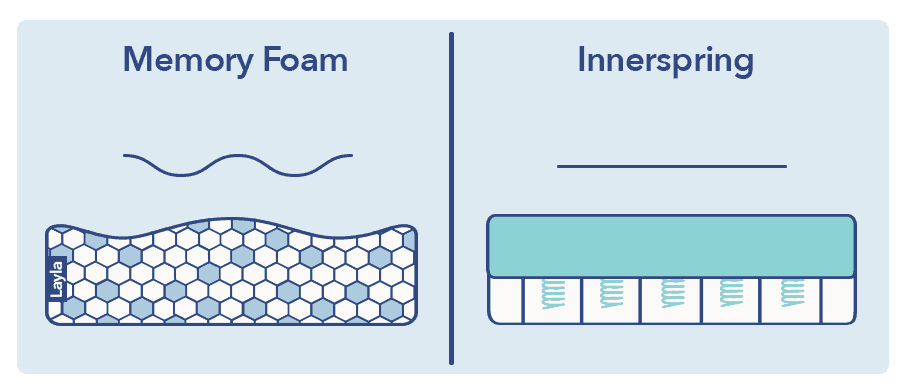
We’ll also note here that if you feel more peace of mind on natural or organic beds, there are a few options you can check out. Natural latex mattresses or mattresses that use CertiPUR-US® Certified foams could fit the bill for you. Our best natural organic mattress guide can help you find a mattress that meets those criteria.
Sleeping Position
Your sleeping position will help you determine which type of mattress might feel most comfortable to you. Take a look at the list below to see what mattress types are best for your sleeping position. And once you’ve found the right bed, peruse our Guide to Better Sleep Posture to get an even healthier night’s sleep.
- Side sleepers often do best on soft, pressure-relieving mattresses. These sleepers might want to opt for memory foam or pillow top mattresses that offer some sinkage and body-contouring.
- Back sleepers can be happy on most different mattress types. If you’re not sure where to start, look into medium-firm hybrid mattresses, which often feel comfortable to a wide variety of sleepers.
- Stomach sleepers normally need firm support. Without firm support, their hips will sink into their mattresses, creating a bend in the spine that can lead to pain over time. Some good options for these sleepers could be innerspring, hybrid, or latex foam mattresses. Mattresses that feature firm polyurethane foam (aka poly foam) could also work for these folks.
- Combination Sleepers usually prefer bouncy, responsive mattresses that make it easy to change positions throughout the night. If you’re a combination sleeper unsure where to start, check out latex or innerspring mattresses.
Body Type
Your body type and weight play a big role in determining what type of mattress will work for you. Depending on how your weight is distributed, you may need extra support around your hips. If you’re someone who carries most of their body weight in their hips, consider a mattress that offers zoned support, which essentially means that a mattress is firmer in certain areas and softer in others. As a brand, Casper has been a pioneer in this field, outfitting its flagship mattress with foams that are firmer in the center of the bed and softer at the shoulders and feet.
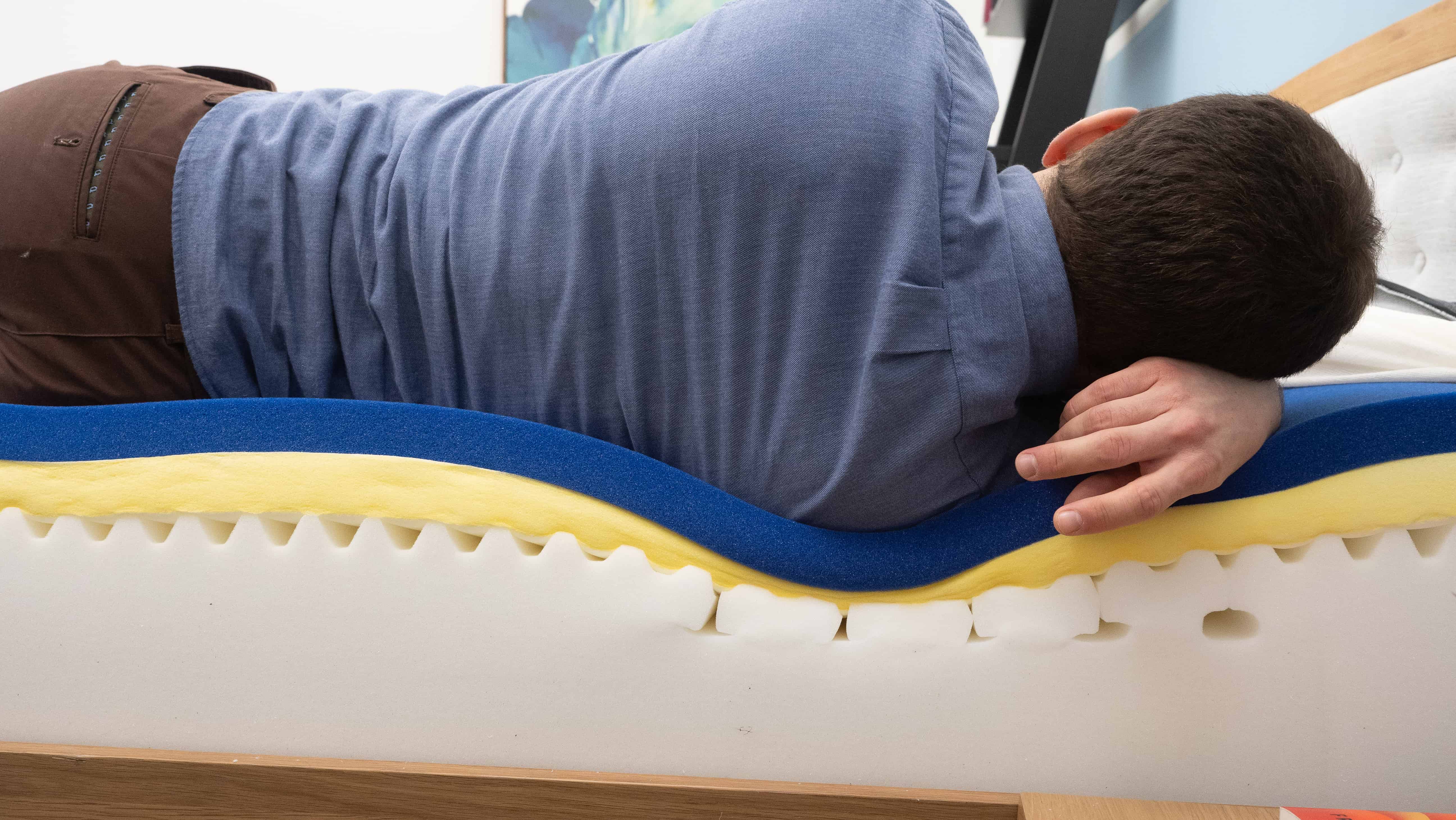
Similarly, heavier people (over 250 pounds) tend to need a mattress that features a strong support system. Innerspring, hybrid, and latex mattresses tend to work best for these sleepers. Some mattress brands also offer models made specifically with heavier folks in mind. We’d recommend checking our best mattress for heavy people roundup to explore some of these options.
Lighter people (under 130 pounds) should consider their weight when purchasing a mattress. Some beds might feel firmer to these sleepers because they don’t sink into the top foams as far as an average weight person would. These sleepers might be most comfortable on pillow top mattresses or softer beds. If you do purchase a bed that feels too firm, a mattress topper could help.
Couples
If you sleep with a partner you’ll want to consider things like motion transfer, edge support, and cooling technology when choosing a bed. You’ll also need to compromise on things like firmness level and feel to ensure both partners are happy. Check out our best mattress for couples, or read more on this guide for sleeping as a couple.
Firmness
Your preferred firmness level will depend a lot on your preferred sleeping position. But if you’re not sure where to start, most people find medium-firm mattresses universally comfortable. For more information on choosing a comfortable firmness level, you can head to our Mattress Firmness Guide.
Pressure Relief
Having a mattress with adequate pressure relief is crucial for any sleeper. Without pressure relief, you’re far more likely to have pressure build on sensitive areas. In turn, this can cause or alleviate back pain and joint pain.
The best mattresses for pressure relief vary from person to person, as different sleeping positions and body types need varying levels of pressure relief. See our roundups of the best soft mattresses and the best mattresses for joint pain for excellent options.
Responsiveness
Responsiveness is a term used to describe how a mattress responds to the pressure we put on it. A mattress with high responsiveness is super bouncy and easy to move around on (typically innerspring and latex beds) while a mattress with low responsiveness has a slower response time (many memory foam mattresses).
The degree of responsiveness your dream mattress has is dependent on your individual needs as a sleeper. If you find yourself changing positions frequently at night, you’re probably going to want one of the best mattresses for combination sleepers. These beds have a higher responsiveness to make moving around on the mattress surface super easy.
Temperature Regulation
Temperature can play a huge role in the comfort of a mattress, and should definitely be taken into consideration when you’re choosing a new bed. Materials like memory foam tend to trap heat and can exacerbate hot sleepers’ problems. If you sleep hot, look for a mattress that features cooling gel infusions or pocketed coils to promote airflow. In general, hybrid and innerspring mattresses tend to sleep fairly cool.
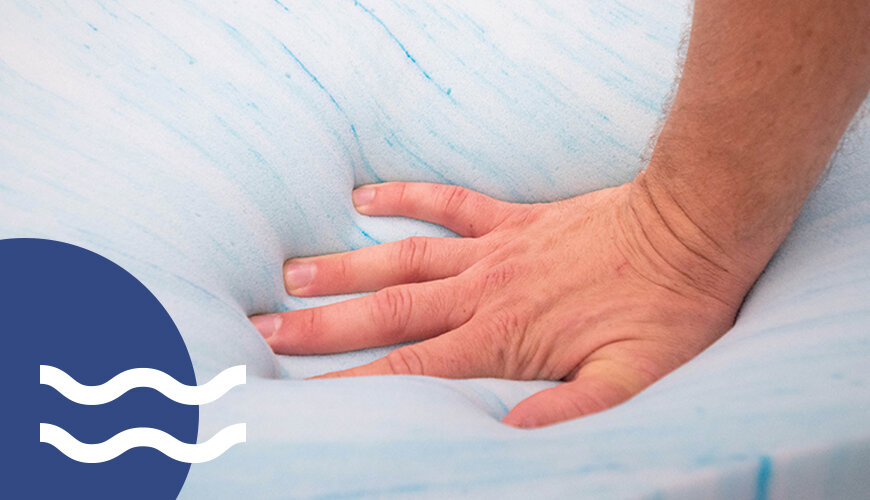
When it comes to cooling, we’d also be remiss not to talk about latex mattresses. Even though they can be more expensive than other mattress types, latex is a naturally cooling material that’s often a great fit for hot sleepers. If you struggle with waking up sweaty, you could find a solution in our best latex mattress roundup. And if you want to learn more about how body temperature affects sleep, dive into our article on thermoregulation.
What Type of Mattress Is the Most Comfortable
There are hundreds of different mattress constructions out there, but which is best?
Memory Foam
Many consider memory foam mattresses to be the most comfortable because memory foam emphasizes pressure relief, contouring, and sinkage. It’s definitely a favorite amongst those with pain problems, including arthritis sufferers. Side sleepers also appreciate the cushioning the foam provides around the hip and shoulder.
For those needing more support, we highly recommend searching for a durable model that uses high-density foams at the foundation. Otherwise, you’ll be much more comfortable on a different mattress type.
Innerspring
These beds are known for being firm, supportive, and responsive. While many may find the thinner comfort layer uncomfortable, others might favor a firmer mattress. We’re looking at you, heavier sleepers and stomach sleepers.
Hybrid
One of the beauties of the hybrid mattress– a bed that combines soft foams and sturdy springs –is that the different brands offer an incredibly wide range of firmnesses and feels. So, hybrid mattresses can be for just about anyone. It’s all a matter of recognizing what you value most in a mattress construction.
Latex
If you’re an eco-conscious shopper wanting a bouncier, more supportive feel, you’ll likely fall in love with the latex mattress. Hot sleepers should also appreciate that latex is a naturally cooling material, so it should help keep night sweats at bay.
Airbed
No, airbeds are not the same as the air mattresses one might use for camping. Airbeds feel a lot more like a traditional mattress, and they include air channels that you may adjust at your leisure. These channels control the mattress’s firmness, so you can pinpoint your own comfort level. This makes airbeds a versatile option that fits just about anyone.
What Is the Most Comfortable Mattress for My Sleeping Position and Body Type
How Important Is Choosing a Mattress for My Body Type?
The biggest mistake folks make is selecting a mattress that doesn’t fit their body type. If you’re a lightweight sleeper who selects an ultra-firm innerspring, you might let the pressure buildup on your joints so much that it evokes pain problems. Heavier sleepers who choose a mattress without enough support might find that their spine gets thrown out of alignment, resulting in back pain.
Lightweight sleepers
- Lightweight side sleepers: memory foam mattress
- Lightweight back sleepers: memory foam mattress
- Lightweight stomach sleepers: hybrid mattress
- Lightweight combination sleepers: latex mattress
Average-weight sleepers
- Average-weight side sleepers: memory foam mattress
- Average-weight back sleepers: hybrid mattress
- Average-weight stomach sleepers: innerspring mattress
- Average-weight combination sleepers: latex mattress
Heavyweight sleepers
- Heavyweight side sleepers: hybrid mattress
- Heavyweight back sleepers: innerspring mattress
- Heavyweight stomach sleepers: innerspring mattress
- Heavyweight combination sleepers: innerspring mattress
How to Pick the Most Comfortable Mattresses for Pain
Pain and low-quality sleep go hand-in-hand. Poor sleep can worsen pain, and uncomfortable pain can worsen sleep.
Back Pain
A mattress that feels medium-firm is one that’s generally best for back pain. The hips need to stay lifted and supported throughout the night, so it’s crucial to have a durable base material. Still, the hips should be cushioned enough to provide pressure relief at the hips. To see our favorite picks, check out our roundup of the best mattresses for back pain.
Hip Pain
Those suffering from hip pain should consider a medium-soft mattress. It’s just a touch below medium-firm and emphasizes pressure relief. But it still provides adequate support to keep the hips lifted throughout the night, which is crucial for achieving proper spinal alignment. For great options, see our roundup of the best mattresses for hip pain.
Shoulder Pain
Folks with shoulder pain should opt for a softer mattress, or one with a thicker comfort layer. That way, the comfort layers take pressure off the shoulder and help you wake up pain-free. For some of our favorite models, see the best mattresses for shoulder pain.
Arthritis
As with mattresses for shoulder pain and hip pain, best mattresses for arthritis excel at pressure relief and allow the joints lots of cushioning. If you’re a heavier sleeper or a stomach sleeper, you’ll definitely want a bit firmer of a mattress, but still something that provides the necessary comfort for your joints.
Other Ways to Make Your Mattress Comfortable
One of the best– and cheapest –ways to make a mattress more comfortable is by adding accessories. Check out some great products and hacks below.
Pillow
Finding and using one of the best pillows on the market can do wonders for your overall comfort and health. They promote a neutral neck and spine alignment while you sleep. We recommend replacing your pillow every one or two years before it loses its shape.
Mattress Topper
If you’re displeased with your mattress’s feel, we recommend using a mattress topper. Many are familiar with a topper’s ability to make a mattress softer, but there are many that make mattresses firmer as well. For some of our all-time favorites, see our roundup of the best mattress toppers.
Flip or Rotate Your Mattress
If it’s recommended by the manufacturer, flipping your mattress or rotating it 180 degrees can make your mattress more comfortable. This allows you to even out the wear on your mattress, which in turn prevents premature sagging and helps extend the lifespan of your bed. It overall makes for a longer, more comfortable sleeping experience.
Most Comfortable Mattress: Details and Pricing
And that wraps up my list. You can review the chart below for one last look at all the coupons and information you need to choose between these beds.
| Mattress | Best For | Price (Queen Size) | Coupon | Review |
|---|---|---|---|---|
| Helix Midnight Luxe | Overall | $2,373 | Helix Coupon | Read Our Review |
| Emma Original | Lightweight Sleepers | $1,399 | Emma Coupon | Read Our Review |
| Nectar | Side Sleepers | $1,049 | Nectar Coupon | Read Our Review |
| WinkBeds | Seniors | $1,799 | WinkBed Coupon | Read Our Review |
| Nolah Evolution | Hip Pain | $2,499 | Nolah Coupon | Read Our Review |
| Saatva | Stomach Sleepers | $1,995 | Saatva Coupon | Read Our Review |
| Bear Original | Athletes | $998 | Bear Coupon | Read Our Review |
| Brooklyn Bedding Aurora Luxe | Hybrid | $2,265 | Brooklyn Bedding Coupon | Read Our Review |
| Titan Plus by Brooklyn Bedding | Back Sleepers | $1,249 | Brooklyn Bedding Coupon | Read Our Review |
| Birch Luxe by Helix | Organic | $3,123 | Helix Coupon | Read Our Review |

